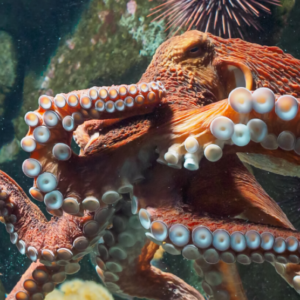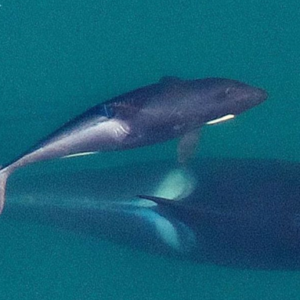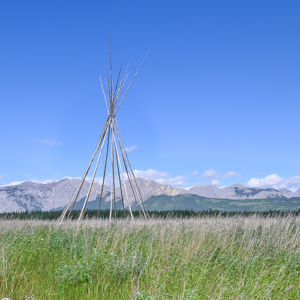An unexpected bird near Wemindji
Since 2012, Nature Canada has worked in close collaboration with the Cree Nation Government (CNG), the Cree Trappers Association (CTA) and more recently, the Eeyou Marine Region Wildlife Board (EMRWB) in support of efforts to identify important bird habitat with and for the First Nations along the eastern coast of James Bay.
Until 2017, our fieldwork was entirely within the territory of the Cree Nation of Waskaganish, but since 2018, we ventured north a few hundred kilometres, in support of the Cree Nation of Wemindji. The village of Wemindji is pretty and picturesque, nestled on an inlet that leads through a maze of scenic islands known as the Painted Hills into the expansive and capricious James Bay.

Our first field expedition into Wemindji territory
This was our first field expedition into Wemindji territory. The Wemindji First Nation passed a Band Council Resolution in support of this work the previous year, so we were delighted when Environment and Climate Change Canada provided Nature Canada with a contract to conduct a late summer (early September) inventory of birds in this area. Our mission was to work closely with our local and regional Cree partners to inventory birds and other wildlife along sections of the Wemindji coast, with the goal of identifying significant shorebird habitat and mapping threatened species occurrences. Shorebirds are one of the most rapidly declining groups of birds in North America. Identifying and protecting their stopover habitat is a key strategy for protecting their populations.
We surveyed areas of the coast and offshore islands where local Tallymen and boat captains Henry Stewart and Ernie Hughboy guided us. Local Wemindji EMRWB Officer George Natawapineskum facilitated all of the local logistics and was often my partner on our daily walks of 6 to 8 hours through boot-grabbing mudflats, wetland vegetation and rocky coastline. Felix Boulanger, biologist of the EMRWB, also a veteran of these expeditions, was Marc-Antoine Montpetit’s daily partners. Marc-Antoine is an expert birder from the Mont Laurier, recruited into our expedition team since 2014 for his great birding skills and familiarity with the coast and culture. The two teams with our respective Tallyman/ Captain would venture to different areas to identify and count all of the birds. Despite the rather late timing of this survey, we were able to observe 96 species and 22,000 individuals in just eight days!
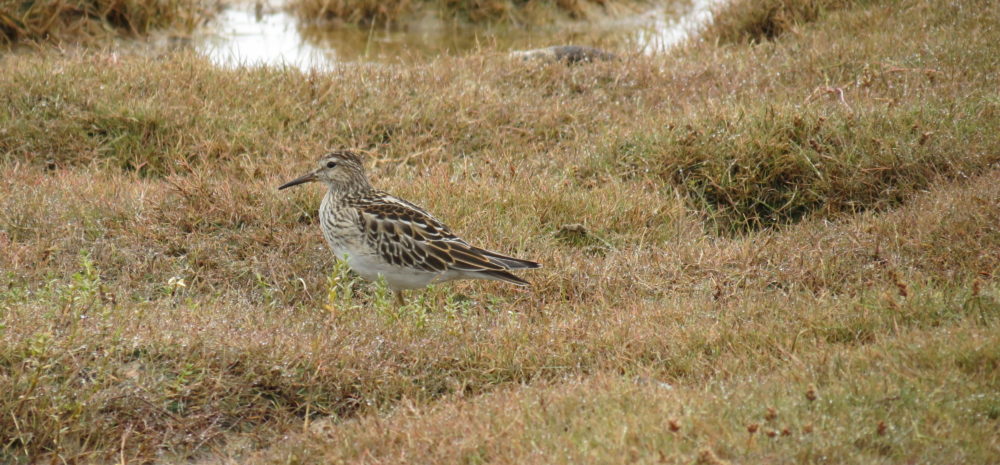
© Ted Cheskey
What rare birds could be spotted?
During the seventeen-hour, 1400 kilometres drive from Ottawa to Wemindji, Marc-Antoine, and I had lots of time to ponder what rare bird species we might find in this new area. At the bottom of that list of potential rarities, more as an afterthought, was Northern Wheatear. It was at the bottom because it was so unlikely. Let’s face it, there were no documented records of this species for the eastern side of James Bay. Though this small, slick-looking songbird breeds on the extreme northern coast of Quebec, Labrador, Baffin Island, and other islands to the north in Nunavut, the closest to Wemindji of a known breeding site was still about 1000 kilometres. That is a long, one-day flight for some of the shorebirds breeding in the same area that migrate south along the James Bay coast. But the reason why so few Northern Wheatears are ever observed anywhere in Canada outside of their breeding area is their special migration.
Unique to North American songbirds, Wheatears migrate eastward to Europe and then south to Africa rather than southward. One bird that was outfitted with a geolocator on September 23rd, on Baffin Island made landfall in Great Britain four days, later, traveling 850 kilometres per day, before flying south to Mauritania on the coast of Africa, where it spent the winter (R.D.Montgomerie, in Richards and Gaston, 2018). Birds are hard-wired for migration, so when a bird turns up outside of its usual route, it is unexpected but exciting for birders.
The fourth day
September 9, our fourth day at Tallyman Henry Stewart’s Akwanaeuwikirrakw Base Camp on Old Factory Bay in Nunavut, started with the sound of rain pounding the roof of our cabin. Fortunately for us, our cabin was also the kitchen and dining room for everyone, so a knock on the door at 6:50 am by James the cook got us up and moving. After breakfast, I stood outside under the eaves of the cabin, shielded from the light rain to observe and count birds largely beyond the shore.
A small bird that was perched about 80 m from me on some pieces of wood caught my attention. Though the light wasn’t good, I was intrigued by its overall look and behaviour. It wagged its tail, a bit like a phoebe, and I could discern a warm rusty colour on the breast. The bird moved off the perch and flew to the right behind trees and the cabins. When it flew, I noticed a flash of white, maybe more than on the outer tail feathers of a pipit, which I initially thought I might be. I went after the bird, but after 5 minutes gave up as we were preparing to leave. Just before heading to the boats, Marc-Antoine spotted, likely the same bird perched a few hundred metres away. “That’s the pipit,” I said as we hurried to our respective boats to take us to the areas scheduled for surveying, already delayed a bit by the rain. I had a lingering doubt that the field marks that I observed didn’t add up to an American Pipit but didn’t share that with Marc-Antoine at the time.
About nine hours later, our boats met up and we returned from our days’ fieldwork to the camp. When we got off the boats, tired, and hungry, looking forward to James’ Moose stew, Felix excitedly said that they had observed something very special. He deferred to Marc-Antoine to provide details. Once we sat in the warmth of the cabin, Marc-Antoine asked me to guess what it might be. “A hint please” I implored. “You mentioned this bird as one of the possible ones in the car on the way up” he replied. “Northern Wheatear?” I offered.
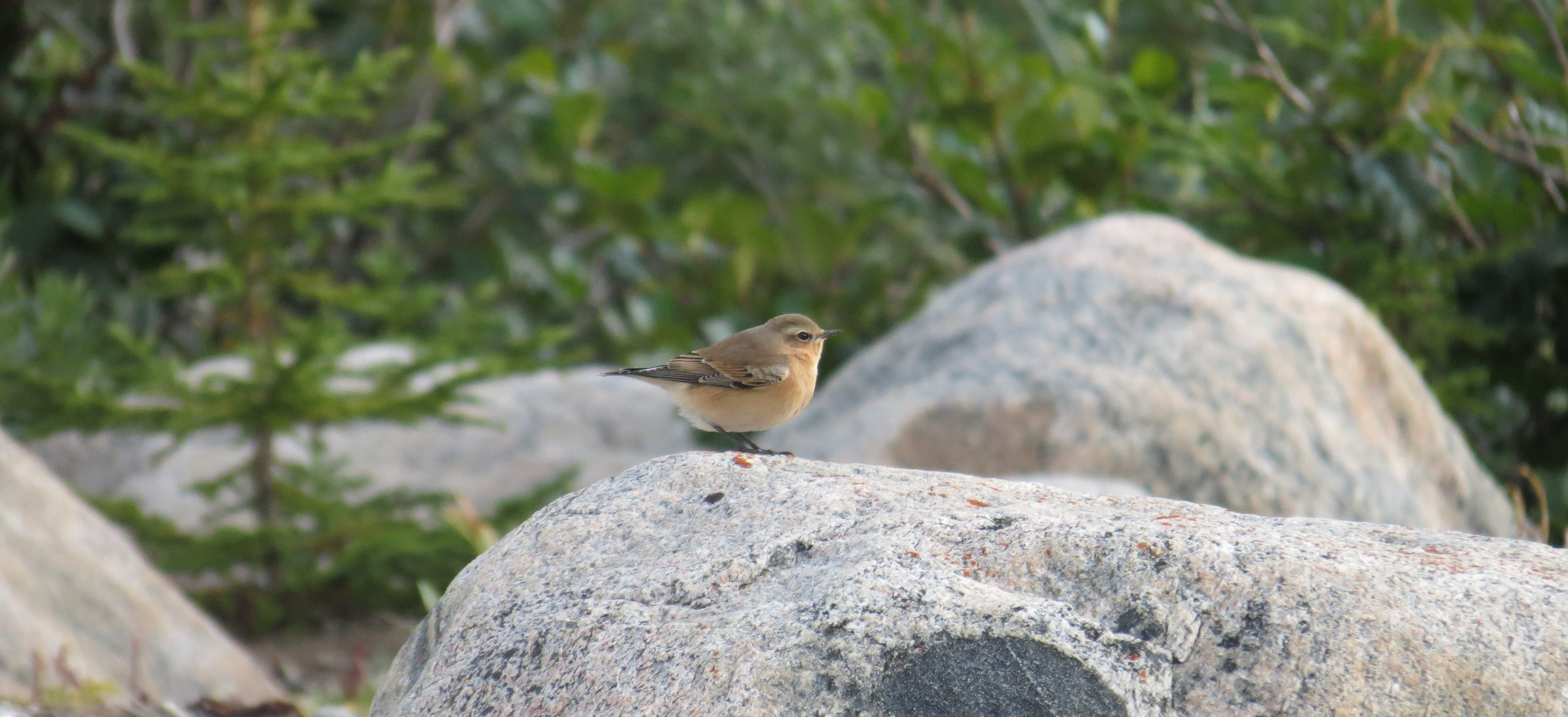
© Ted Cheskey
A notable encounter
Bingo . . . Marc-Antoine went on to explain the circumstance around the observation . . . a glimpse of a different looking bird, on this rocky, arctic-tundra-like island. A rich rufous wash to its breast, a flash of white when it flew, and some tail bobbing. Initial confusion with American Pipit, some of which had the same rusty colour in the breast at this time. Then the key moment, when he saw the white rump, then there was no doubt – this was a Northern Wheatear. While I was excited for them, I was haunted now by the earlier observation. I hesitated . . . “I think that I saw the same species earlier this morning right here in front of the cabin. Let’s see if we can find it?” Out we went, and within 200 metres we found it . . . Marc-Antoine’s second Northern Wheatear in one day, and my first. One is extraordinary. Two . . . well, a statistician might say that is the beginning of a pattern.
We celebrated the visit of this unique arctic songbird to coastal Wemindji in the warmth of the cabin and James’ superb meal. We had so many questions such as “are there more out there?”, and “could this be a regular occurrence along the coast that no one has noticed because of the remoteness, the timing and the similarity of this bird with pipits?” It also served as a good reminder about observing birds, noticing details and trusting your intuition. Marc-Antoine kept after his Northern Wheatear, although his initial impression was that it might be an American Pipit, because his intuition told him that the field marks and behaviour didn’t add up, and he stayed with it until he confirmed its identify. As always, there are the “if I did this differently” thoughts, and mine was that if I had shared with Marc-Antoine my doubts about the “pipit on the rock” before we headed out to do our surveys, we would have surely identified it correctly, and the Island Wheatear would have been his second of the day.

